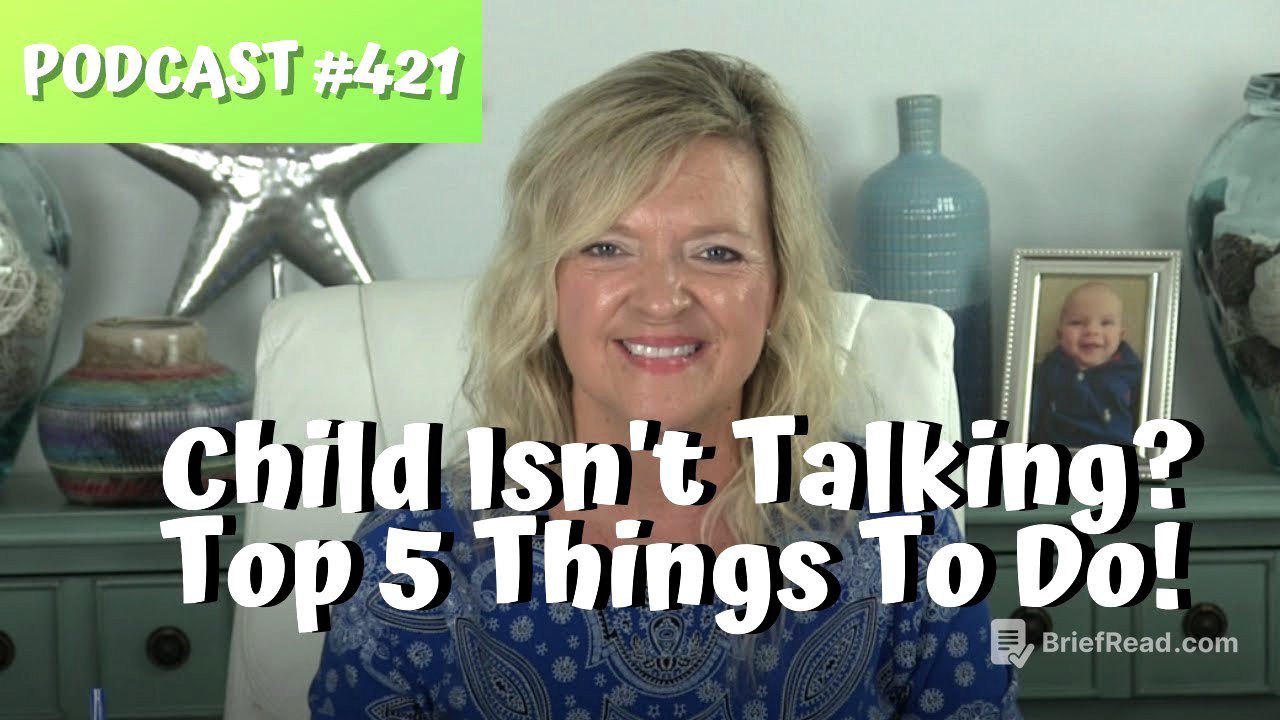TLDR;
This podcast episode by Laura Mize from "teachmetotalk" focuses on the top five strategies for parents of late-talking toddlers and preschoolers to encourage language development. These strategies emphasize the importance of dedicated time, simplified language, reciprocal imitation, focusing on play sounds, and using verbal routines. The goal is to provide parents with practical, evidence-based techniques to support their child's communication skills.
- Devote time and effort to language activities.
- Simplify language for better understanding.
- Use reciprocal imitation to encourage communication.
- Focus on play sounds before words.
- Implement verbal routines for predictability and language learning.
Introduction [0:18]
Laura Mize introduces the podcast, focusing on the top five strategies for parents of late-talking toddlers and preschoolers. She emphasizes that these strategies are the first things she teaches parents to do, setting the stage for success. The information is designed to be adaptable for a wide range of families, with adjustments based on individual child needs, such as prioritizing social interaction for children with markers for autism. The podcast aims to educate parents and provide therapists with tools for their practice, including CEU credits and handouts available at teachmetotalk.
Strategy 1: Devote Time and Effort [2:43]
The first strategy involves parents dedicating specific time and effort to working with their toddler. Laura advises against believing that small tweaks will suffice, emphasizing the need for focused, one-on-one time. She notes that children whose parents prioritize dedicated time tend to make the most progress. While incorporating strategies into daily routines is valuable, prioritizing focused intervention is crucial. She suggests starting with short, focused bursts of 10 minutes, free from distractions like screens. Activities during this time can include reading books, playing, or engaging in social games.
Strategy 2: Simplify What They Hear [16:01]
The second strategy focuses on simplifying the language a child hears. Laura explains that the language a child hears directly impacts their ability to learn to talk. She stresses the importance of changing the language used around the child, especially for those with receptive language issues. She advises assessing a child's understanding by observing their ability to follow simple, familiar commands consistently. She introduces the "tell them, show them, help them" approach for giving directions and encourages parents to involve their child in daily routines by assigning them specific tasks paired with verbal commands.
Strategy 3: Respond to and Repeat Every Noise [34:02]
The third strategy involves parents responding to and repeating every noise their child makes, known as reciprocal imitation. Research indicates that children who made significant progress from language delays had parents who were good at imitating non-words. Laura explains that all words start as non-words, and by repeating a child's sounds, parents tune in and shape those sounds into recognizable words. She encourages parents to assign meaning to these sounds and model them, helping the child move closer to saying actual words.
Strategy 4: Focus on Play Sounds [39:37]
The fourth strategy shifts the focus from real words to play sounds. Laura advises parents to get their child "noisy" before focusing on words, explaining that play sounds come before words. She suggests using sound effects and exclamatory words to meet the child where they are developmentally. She recommends incorporating these sounds into play and daily routines, using the child's favorite toys and activities. Laura encourages parents to analyze the sounds their child can already make and create play sounds that utilize those phonetic abilities.
Strategy 5: Use Verbal Routines [48:34]
The fifth strategy involves using verbal routines to make it easier for a child to use real words. Laura defines verbal routines as saying the same things at the same time, with the same words, in the same way. She draws a parallel to adult neuro patients, where automatic speech is used to regain language. She suggests using familiar songs, counting, and repetitive phrases to make words automatic for the child. Laura emphasizes the importance of predictability and repetitiveness, using techniques like expectant waiting to encourage the child to fill in the missing word in a routine.
Review of Strategies [58:07]
Laura reviews the five strategies: devote more time to working on language, simplify language, use reciprocal imitation, make more noise and use less words, and use verbal routines. She reiterates the importance of being intentional, simplifying language for better understanding, repeating the child's sounds, modeling sounds, and using predictable routines. She reminds parents that progress may take longer for children with receptive language delays, as they need to understand the words before they can say them.
Resources and Conclusion [1:01:56]
Laura mentions several resources, including her therapy manuals "Building Verbal Imitation Skills in Toddlers," "Teach Me to Play with You," and "Let's Talk About Talking." She emphasizes the importance of these resources for speech-language pathologists, early intervention professionals, and parents working with their children at home. She concludes the podcast, thanking listeners and encouraging them to subscribe to her YouTube channel.
